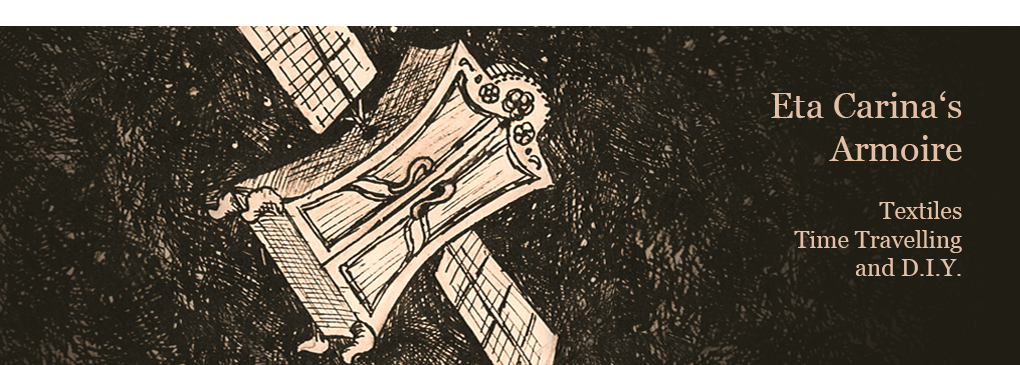Letzten Monat habe ich neue Cyanotypien gemacht. Zwei Serien sind daraus entstanden: Zum einen habe ich angefangen, Arbeitsmaterialien, die ich zum Nähen gebrauche, zu arrangieren und daraus Bilder zu machen. Zum anderen habe ich meine "Cyanori"-Technik weiterentwickelt (ja, ich nenne es immer noch so...)
Für die erste Serie begann ich mit Scheren und anderem Schneidwerkzeug. Danach benutzte ich auch Spulen und Massbänder, legte eine Ansammlung von Knöpfen und anderen Schliessen aus. Zuletzt belichtete ich noch Einzelteile meiner Nähmaschine (das brauchte die meisten Versuche, bis ich zufrieden war).
Zwei entwickelte Cyanotypien beim Trocknen:
Bei den Cyanoribildern fing ich zuerst wieder an, mit Vorstichen durch den Stoff zu nähen und sie nach Gefühl zusammenzuraffen. Das gab zwar zwei schöne Bilder, das Resultat ist so aber generell schwierig zu kontrollieren, da sich der Stoff garantiert nie so faltet, wie man es gerne hätte.
 |
| Spiralförmig nähen und zusammenziehen |
 |
| Parallel nähen und zusammenziehen |
Als Stoff benutzte ich wieder beschichtete Leintücher, wie in meinen ersten Cyanotypie-Versuchen. Diese sind fein gewebt und trotzdem robust. Das war wichtig, da ich die Bilder am Schluss auf Keilrahmen spannte. Ursprünglich wollte ich an dieser Stelle Schritt für Schritt zeigen, wie ich dabei vorgegangen bin. Es war dann aber viel einfach "Try and error", vor allem bei den Ecken, so dass ich nicht viel Hilfreiches dazu sagen kann.
 |
| Bildausschnitt suchen |
 |
| Ecken einschneiden |
 |
| ...und tackern! |
Liebe Grüsse
Eta Carina
Hello
Last month I made several new cyanotypes. I made two series of pictures: One where I arranged materials and tools I use for sewing. And one where I worked further on my "Cyanori"-technique (yes, I'm still calling it like that...)
I began the first series with arranging scissors and other tools for cutting. Then I proceeded to spools and measuring tape and laid out different buttons and other closures. Finally I took out the different parts of my sewing machine and exposed those (that last one took me the longest until I was happy with the result).
For the Cyanori pictures I started with doing a running stitch and then gathering the fabric. This lead to two nice images, but ultimately the results where just to hard to control like that. The pleats would just never be like I wanted them to.
Then I got the idea to use smocking. With this technique you also create a pattern by gathering the fabric. But here the folds are stabilized by regular backstitches to keep the folds in place. Usually you first draw a grid onto the fabric to know where to stitch. And of course, usually the stitches remain. I found Azalia Designs videos very useful. She shows and explains a wide variety of standard smocking patterns. So I could just look them up and try some of them out. It's a fascinating technique with a lot of possibilities for experimenting.
Like in my first cyanotype attempts I used linen sheets. They are finely woven but at the same time robust. This was important as I would stretch the pictures over a wooden frame. I had actually planned to give a step-by-step turorial for this, but a lot of it was just "try and error", especially when it came to getting the corners straight, so I haven't got a lot of helpful tips on that.
But the best part is that I can show those pictures at the Alja fabric shop in Lucerne. I am very happy that this is possible! I hope the customers will enjoy my pictures. And who knows, if you happen to be in Lucerne the next few weeks, you could go and have a look for yourself...
Best wishes
Eta Carina












